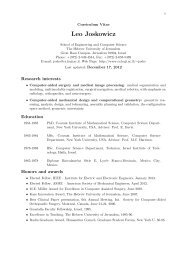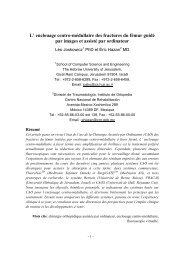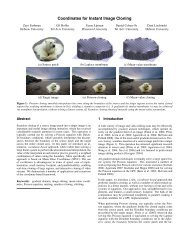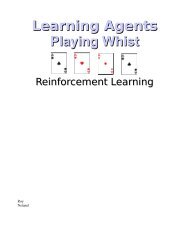TEL AVIV UNIVERSITY Gaddi Blumrosen
TEL AVIV UNIVERSITY Gaddi Blumrosen
TEL AVIV UNIVERSITY Gaddi Blumrosen
You also want an ePaper? Increase the reach of your titles
YUMPU automatically turns print PDFs into web optimized ePapers that Google loves.
extended channel response. In SISO modeling where there was only one receive one<br />
transmit antenna, the antenna array response could have been seen as one. With the<br />
assumption that the steering vector is time independent, each element of H, can be<br />
expressed as a function of its steering vector and its fading coefficients e.g. as in [4],<br />
[5], [13]:<br />
hi, j ( t, ) st, i ( ) i, j ( t, ) sr, j ( ) stl,<br />
i ( l ) sl, i, j ( t, l ) srl,<br />
j ( l<br />
) (2.13)<br />
Where 1... N , j 1...<br />
N , l 1...<br />
L and s ( ) s ( ) are transmit and receive<br />
i t<br />
r<br />
steering vectors i'th element, respectively. Each elements, ( t,<br />
)<br />
, is a complex<br />
random variables reflecting the channel statistics. Fig. 1 shows a diagram of a general<br />
MIMO system. In our system model, flat fading, i.e. L=1, is assumed:<br />
h ( t, ) s ( ) ( t, ) s ( )<br />
(2.14)<br />
i, j t, i s, i, j r, j<br />
Correlated MIMO channel<br />
l<br />
t,<br />
i <br />
r,<br />
i <br />
For analyzing the correlated MIMO channel we define the correlation coefficients<br />
between each element as follows:<br />
i j E hi hj<br />
<br />
(2.15)<br />
where h is an vector formed by, the operator vec which is the span of H<br />
*<br />
, <br />
N 1<br />
r Nt<br />
*<br />
columns to one column and iE( hihi) 1. Following, the correlation matrix, Rhh<br />
, is<br />
defined as:<br />
H<br />
R [ ] E(<br />
h h)<br />
(2.16)<br />
hh i, j<br />
The additional input parameters to the MIMO model compared to the conventional<br />
SISO models, are the antenna correlation matrices at transmit and receiving ends.<br />
These correlation matrices might be selected to be different for each delay component<br />
in the radio channel. We assume fixed correlation matrices, i.e. time-invariant, but the<br />
model can be extended to support time-varying correlation matrices as in [13].<br />
Another common assumption, as in [4]-[13], based on the fact that correlation is<br />
caused by the nearby surrounding of the antenna array, is that the correlation between<br />
the receive antenna elements are independent of the transmit antennas. Let us define<br />
now, RT as the transmit correlation matrix as of size Nt Nt<br />
, where the index of the<br />
receive array is fixed on one element:<br />
H<br />
RT<br />
E(<br />
H H)<br />
(2.17)<br />
Similarly we define Nr Nr<br />
receive correlation matrix, R , where the index of the<br />
transmit array is fixed on one element<br />
(2.18)<br />
In the general case, of scatterers on the propagation path, we define the elements,<br />
based on general scatterers‟ distribution, same as in [5], as:<br />
(2.19)<br />
R<br />
H<br />
RR E(<br />
HH )<br />
RR<br />
r / 2 di<br />
, j<br />
i2<br />
sin( )<br />
<br />
<br />
<br />
e p(<br />
)<br />
d<br />
i j<br />
RR<br />
i,<br />
j <br />
r / 2<br />
<br />
1<br />
i j<br />
hi, j








